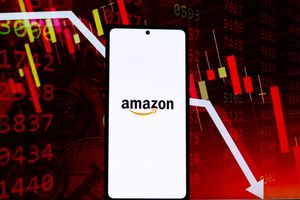
Food and beverage company PepsiCo (NASDAQ: PEP) announced better-than-expected revenue in Q2 CY2025, but sales were flat year on year at $22.73 billion. Its non-GAAP profit of $2.12 per share was 4.5% above analysts’ consensus estimates.
Is now the time to buy PEP? Find out in our full research report (it’s free).
PepsiCo (PEP) Q2 CY2025 Highlights:
- Revenue: $22.73 billion vs analyst estimates of $22.35 billion (flat year on year, 1.7% beat)
- Adjusted EPS: $2.12 vs analyst estimates of $2.03 (4.5% beat)
- Adjusted EBITDA: $4.72 billion vs analyst estimates of $4.58 billion (20.8% margin, 3% beat)
- Operating Margin: 7.9%, down from 18% in the same quarter last year
- Organic Revenue rose 2.1% year on year, in line with the same quarter last year
- Sales Volumes fell 1.5% year on year (-3% in the same quarter last year)
- Market Capitalization: $199.1 billion
StockStory’s Take
PepsiCo’s first quarter results were met with a negative market reaction as the company delivered revenue slightly above Wall Street expectations but reported a modest year-on-year sales decline. Management attributed the softness to continued volume pressures in North America, particularly in its Frito-Lay snack business, and highlighted ongoing challenges from a cautious U.S. consumer and operational disruptions. CEO Ramon Laguarta acknowledged, “We’re starting to see the returns on some of the value and new price points investments that we’re making,” but emphasized that these strategies are still early in rollout and that consumer weakness and cost pressures weighed on performance.
Looking forward, PepsiCo’s guidance reflects mounting external pressures, including newly implemented tariffs and greater macroeconomic uncertainty. CFO Jamie Caulfield cited tariffs as a key reason for the reduced full-year earnings outlook, alongside subdued North American snack performance and a less optimistic view on consumer confidence. Management expects international operations to remain the primary growth driver, with Laguarta noting, “International will continue to be a growth and profit key driver for the company for the long term.”
Key Insights from Management’s Remarks
Management pointed to three main factors behind the quarter’s performance: persistent U.S. volume softness, new tariff costs, and continued investment in pricing and product innovation.
- Frito-Lay volume challenges: Management described ongoing weakness in North American snack volumes, with particular emphasis on the need to adapt pricing and package sizes to meet value-conscious consumers. Initiatives like dual-size strategies and lower entry price points for single-serve snacks are being deployed to support unit growth.
- Tariffs introduce margin headwinds: Newly enacted tariffs were cited as a significant source of incremental cost pressure impacting the full-year earnings outlook. CFO Jamie Caulfield stated that mitigation strategies are being developed, but some cost absorption is unavoidable in the near term.
- International momentum offsetting U.S. softness: The international segment continued to deliver solid growth, especially in markets like India and Brazil. Management said these regions are benefiting from increased investment and are expected to drive mid-single digit growth, even as China and Mexico face consumer headwinds.
- Portfolio transformation and innovation: PepsiCo is accelerating the shift toward more “permissible” and functional snacks, reducing artificial colors and expanding options tailored to consumer dietary trends, such as higher fiber and hydration products. The company’s response to GLP-1 medication trends includes developing new products with more protein and fiber.
- Operational improvements after SAP transition: Frito-Lay’s recent SAP system implementation has temporarily disrupted operations but is expected to enhance execution and service levels in coming months. Management expects improved data and process efficiency to support better retail execution and cost control.
Drivers of Future Performance
PepsiCo’s outlook for the rest of the year hinges on international demand, margin management in the face of tariffs, and the pace of recovery in North American snacks.
- International expansion as growth lever: Management reiterated that international markets are now accretive to both revenue and profit. Ongoing investment in brands, talent, and capacity is expected to sustain mid-single digit growth, with regions like Europe, India, and Brazil highlighted as key contributors.
- Tariff and cost headwinds: The company’s full-year earnings guidance now incorporates the expected impact of tariffs, which management is attempting to mitigate through productivity initiatives and selective price adjustments. However, some cost pressures are likely to persist throughout the year.
- North America snack recovery timeline: While management is executing a multi-pronged turnaround strategy for Frito-Lay, including value-oriented packaging and operational improvements post-SAP rollout, they caution that volume and margin recovery will be gradual and dependent on consumer sentiment and execution effectiveness.
Catalysts in Upcoming Quarters
Going forward, the StockStory team will look for (1) evidence that Frito-Lay’s volume turnaround strategies are translating into sustained growth, (2) the effectiveness of tariff mitigation in stabilizing margins, and (3) continued momentum in international markets, particularly as investments in new product innovation and operational efficiency take hold. Progress on adapting to regulatory changes and evolving consumer health trends will also be closely monitored.
PepsiCo currently trades at $145.24, up from $135.35 just before the earnings. In the wake of this quarter, is it a buy or sell? Find out in our full research report (it’s free).
Now Could Be The Perfect Time To Invest In These Stocks
When Trump unveiled his aggressive tariff plan in April 2024, markets tanked as investors feared a full-blown trade war. But those who panicked and sold missed the subsequent rebound that’s already erased most losses.
Don’t let fear keep you from great opportunities and take a look at Top 9 Market-Beating Stocks. This is a curated list of our High Quality stocks that have generated a market-beating return of 183% over the last five years (as of March 31st 2025).
Stocks that made our list in 2020 include now familiar names such as Nvidia (+1,545% between March 2020 and March 2025) as well as under-the-radar businesses like the once-small-cap company Comfort Systems (+782% five-year return). Find your next big winner with StockStory today.
StockStory is growing and hiring equity analyst and marketing roles. Are you a 0 to 1 builder passionate about the markets and AI? See the open roles here.






